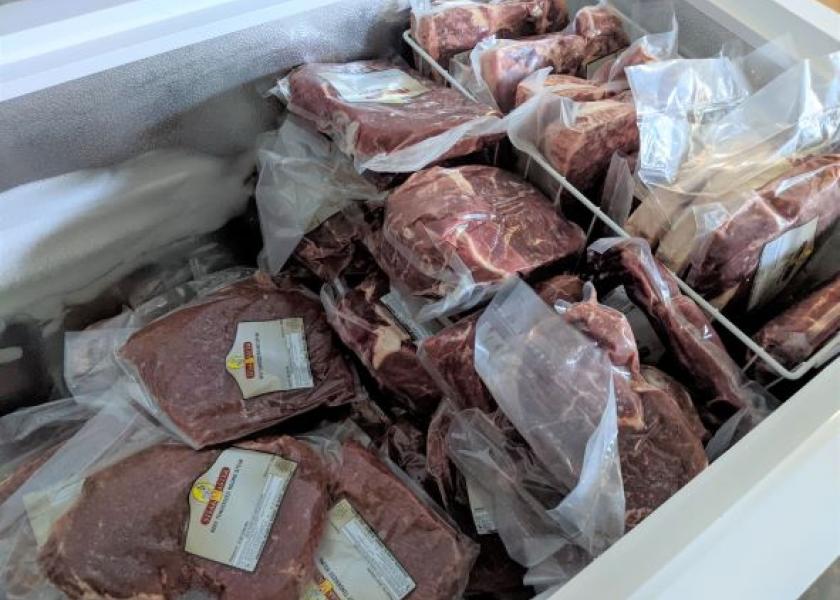Before The Freezer: Selecting the Best Calf with Beef in Mind

Have you ever experienced the taste of home-raised beef? For those who choose to finish out their own beef, it’s processed locally, they know where their beef comes from/how it was raised, and they know what it was fed from start to finish.
But, how does one begin feeding a beef animal? Also, what breeds are best and what characteristics are important in selecting to provide the best product in the end?
Whether you are selecting an animal from your own herd, buying at the livestock market or selecting from a local producer’s herd, it’s important to get started on the right foot.
Step 1: Breed Selection
Starting with the breed, choosing an animal based on genotypic qualities can help you get started in a desired direction.
Cattle breeds can be broken down by dairy production and beef production.
“While dairy cattle, such as Holsteins, are regularly fed out for their meat, it should be noted that these breeds may yield less overall consumable product and produce a smaller steak size, often due to their larger frame size and lower genetic ability to develop muscle,” says a University of Nebraska (UNL) article.
Beef breeds tend to provide more muscling capabilities and will provide more finished, cutable product.
Step 2: Weight Considerations
When do you want to have this animal finished? It may depend on when you can get a date at the processor. Local locker space filled up quickly during the pandemic and many still have waitlists or are booked for several months in advance.
Figuring three pounds of gain per day and a 1300-1400-pound finishing weight, calculate to find the approximate weight of calf that should be started to reach the appropriate weight according to the processing date. For example, if the processor appointment is made for 200 days from now, with a daily gain of 3 pounds per day, the animal will gain approximately 600 pounds. Therefore, an animal weighing 700-800 pounds would be a reasonable starting weight.
Step 3: Weaning and Calf Health
Choosing an animal to feed requires consideration of calf health. If possible, finding a calf from a local producer or keeping one from your herd allows you to know the whole health history of the animal. Buying an animal from a livestock market is another option but may increase the risk of disease as the animal co-mingles with other animals at the barn.
Also, consider feeding a weaned calf. A long-time weaned calf, over 45 days for example, commonly has less health issues and will be bunk broke.
When feeding an animal to 1300+ pounds, the calf’s structure is also important.
“Begin with the legs and feet of the calf. A feeder calf that is sound on its feet and legs should be straight up and down from the front and rear view, with all four hooves pointing forward and possess an even claw set,” the article explains.
Though most animals aren’t going to be perfect in structure, the ideal pastern set of a feeder calf is 45 degrees from the side view.
Avoid feeding an animal with major structure issues, a limp, abscess or other issues that will likely be multiplied as the animal grows.
Step 4: Carcass Grading
Frame sizes and width help determine the ‘thriftiness’ of the animal in the standard grading system.
Calves are categorized by a small, medium, or large frame size. A large frame, market-ready steer will finish around 1300-1400 pounds. Though large-framed calves take longer to reach finishing weight, these animals will yield larger steaks and a greater amount of meat in the end, says the article.
Heifers will likely mature quicker and finish at a lighter weight than steers.
Cattle that are “moderately thick throughout, round through the back and loin with moderate width between the front and rear legs” will grade the highest or as number one grade, the article explains.
Lighter muscled and narrower cattle grade lesser, number 2-4, respectively. A number 5 grade animal would be considered “inferior” and are not expected to perform well.
Feeding a calf is an investment. Buying the animal, feed costs, processing fees and the time invested add up quickly. However, as consumers face rising prices at the store and as beef is imported from other countries to be sold in local U.S. meat markets, the lower average cost per pound of beef and knowing where your beef comes from might make feeding your own beef the most economical and conscious decision as a consumer.







